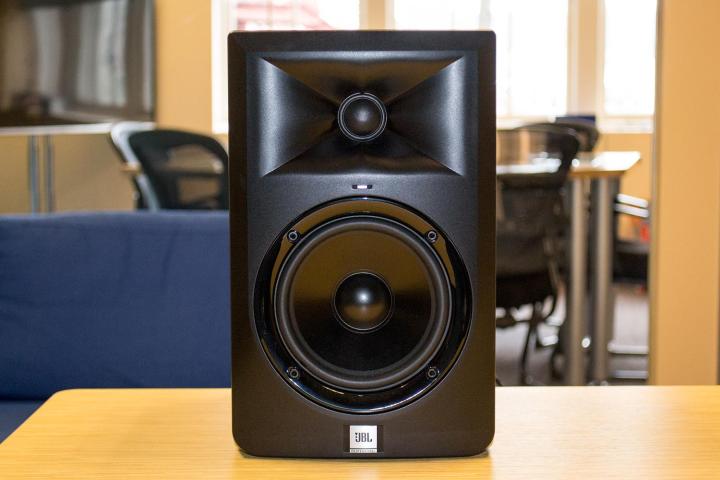
Read our full written JBL LSR305 review.
A couple years back, JBL set out on a mission to create the ultimate mastering quality studio monitors. After several evolutions (and some constructive criticism from Grammy award winning producer Frank Fillipetti) JBL’s efforts bore fruit in the form of the M2 Master Reference Monitors, a $26K+ pair of monoliths that hold a host of patents, and boast “revolutionary” sound thanks to the incorporation of several new technologies.
While you may not be able to drop over twenty grand on speakers, JBL has thoughtfully leveraged some of that sparkling M2 technology to create an affordable new consumer reference speaker, the LSR305. We recently got a chance to check out a pair of the LSR305’s for ourselves, and we have to say, the results were pretty impressive.
The entry level for JBL’s new 3-series of consumer-grade monitors, the LSR305 boast an extremely budget-friendly price tag of around $150 per speaker. The speakers are self powered, and offer both XLR and quarter-inch inputs, allowing you to drive them with just about anything in your arsenal, from an iPhone to a professional DAC.
But the LSR305’s secret weapon is the employment of JBL’s latest waveform technology, called Image Control Waveguide. Designed to manipulate waveform distribution to provide full sound to any point in the room, the sharing of the M2’s prized technology represents the upside of spending a small fortune on R & D. Far from the usual DSP trickery and room correction technology employed by many high-end monitors and shelf speakers, ICW is a form factor built into the cabinet itself that physically manipulates the wave as it exits the tweeter. And it’s like nothing we’ve encountered before.
As we sat down in front of the LSR305s during a brief demonstration, our first impressions were similar to just about any other monitor we’ve encountered in countless studios and home mix stations. The speakers boast a standard 5-inch driver at the bottom, and above, a decidedly ordinary-looking dome tweeter. However, looking closer revealed a strange set of contours around the tweeter’s baffle, as if it were buckling in on itself like a black hole. Curved into strange points around each tweeter’s circumference were odd horns of formed plastic that stuck out like the pointy ears on Batman’s mask.
Those weird contours are the secret behind JBL’s patented wave shaping technology, and they do some crazy things with the sound. We’re not going to say JBL re-invented the wheel here, but they certainly re-invented the way these little ‘wheels’ emit sound through the air. And honestly, we’re amazed someone hasn’t thought of this before.
Firing up the LSR305s, we were impressed with how they handled some of our go-to test tracks, creating a rich, balanced reproduction of everything we threw their way, from Radiohead to Ray Lamontagne. The speakers unearthed a midrange that was warm and smooth, extending far into the upper register, before opening into a clean and accurate treble section. Bass was full, if not a little light at the low end, and the speakers did an admirable job of carving out rich textures from crushed snare and toms, while delineating vocals with stark clarity.

First impressions from the sound signature alone were enough to get us fairly excited about these affordable monitors. But the real star of the show was revealed when we started to move away from the apex of the listening point. While the center image was pointed and well-defined from the optimal center position, moving far left or far right of the center yielded some intriguing results. Panned instruments stayed put, but the center image seemed to follow us into the periphery like a laser beam. Moving all the way right or left, vocals still sounded dead on, as if the speaker were mono, yet we could also delineate the stereo panning fairly accurately.
The result of this heat-seeking missile of a center image was a wide and almost omnipresent sound signature that filled the room and kept us in the groove from virtually any forward facing position. On the other hand, we also felt like we didn’t hear quite as much placement accuracy across the stereo image as we’d like. But then again, these speakers are only $300 for the pair.
JBL hopes to market the LSR305, and their big brother, the LSR308 8-inch monitors, to a host of music lovers, from DJs and aspiring engineers, to those who just want to enhance their home theater on a budget. We’ll have to wait for a full review to give a wholehearted thumbs up, but so far, color us impressed. We’ll likely have the speakers in for review soon, so stay tuned. Or if you can’t wait, you can pick up JBL’s 3-series speakers and listen to them for yourself today.





